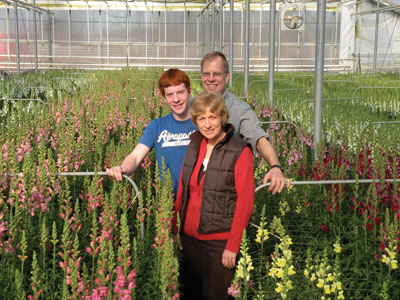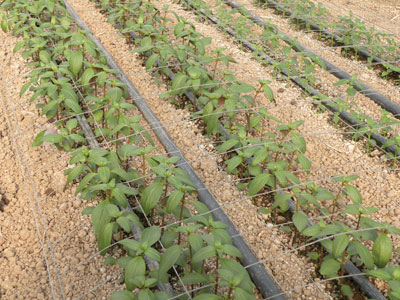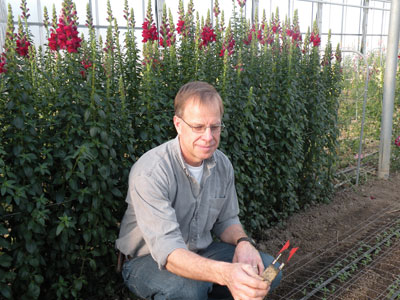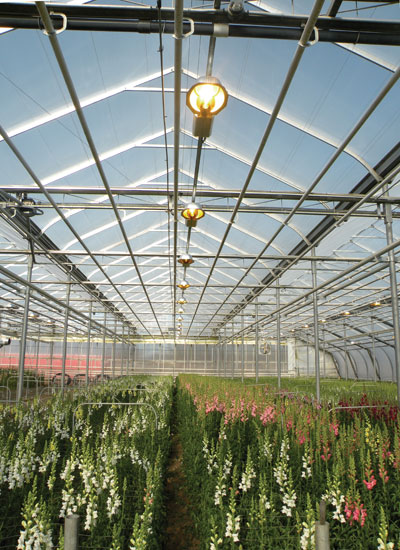
Joel Wiersma may be a relative latecomer to the greenhouse industry, but he’s making up for lost time with his dedication to research and innovation. The result has been consistently high quality crops and many happy customers.
Joel Wiersma may be a relative latecomer to the greenhouse industry,
but he’s making up for lost time with his dedication to research and
innovation. The result has been consistently high quality crops and
many happy customers.

|
| Alice, Steve and Joel Wiersma, of Glanbrook Gardens. Advertisement
|
Joel and his wife Alice own Glanbrook Gardens Ltd., a cut snapdragon
operation located just minutes from Hamilton, Ont., and centrally
located within southwestern Ontario.
Joel had previous careers as an auto mechanic and in the
telecommunications field, before he and Alice decided to establish a
home business on their 13-acre property. Neither grew up in greenhouse
families, but both share a love of plants.
They started with a 2,000-square-foot hoop house and began with
begonias and later gloxinias. In 2001, they built a 22,000-square-foot,
state-of-the-art greenhouse.
With the larger facilities, they began looking for a new crop. “We had
been told to grow something that nobody else grows, because that would
be our niche.” However, after they studied a specific product, they’d
be cautioned, “there’s a reason nobody grows that.” It’s humorous to
recall now, but at the time it was a little frustrating. What would
they grow?
“After a lot of research, we finally decided on snapdragons,” Joel explains during an early morning tour.
 |
|
| Young plants, off to a good start. |
|
 |
|
| Joel Wiersma with one of four probes used to monitor moisture levels. |
|
 |
|
| Cut snapdragon demand doesn’t ease in the winter, and the lights ensure optimal yields and quality during short days. |
SNAPDRAGONS ARE ESSENTIAL FLOWERS FOR FLORAL DESIGNERS
It was a good choice. Snapdragons are valuable tools for florists and
floral designers because of their height and range of colours. They add
considerable value to any floral display or bouquet.
Of Canada’s total cut flower production in 2008 of 236 million stems,
some 14.1 million were snaps, according to Statistics Canada. It was
the fifth largest cut flower crop in Canada that year, following tulips
(69 million), gerbera (51.4 million), mums (14.8 million) and
alstroemeria (14.6 million).
In 1998, Canada produced some 9.1 million cut snaps. Not a lot of cut flowers have seen the same rate of increase.
With his technical background, Joel is quite analytical in problem
solving. Early on, when faced with plug problems, he would tri.al 50
different scenarios of various products to determine what worked best.
The result was his own unique recipe for healthy plugs.
For a few years, the Wiersmas also experienced infestations of garden
sympylans (Scutigerella immaculata), sometimes called the garden
centipede. The bugs would work their way down rows, eating away at the
roots. Joel’s research eventually extended all the way to California,
where he contacted an expert who provided key advice in solving the
problem. “We were finally able to control them,” he said.
MONITORING TO MAINTAIN CONSISTENT SOIL MOISTURE LEVELS
Another challenge was maintaining consistent soil moisture levels.
After extensive research, Joel settled on a capacitance probe
tensiometer monitoring system. He’s not aware of other growers using
these probes.
There are four probe sensors located throughout the greenhouse. “It’s
been quite effective for us, helping maintain exactly the moisture
levels we want,” Joel said. It’s just one less thing to worry about,
though he periodically double-checks the system with a handheld
sensor.
The system saves a lot of money. “We now use much less water and
fertilizer, and the growth is consistent.” Accurate watering also
reduces problems associated with over-watering, such as root diseases.
“And if you don’t water enough, you end up with inferior flower heads
and stunted plants.”
The Wiersmas weren’t long into snaps before seeing that winter market
demands can often be much higher than the supply. The solution was to
install lights, something not common with snapdragon crops. While a
considerable extra expense, the investment quickly paid for itself in
greatly improved winter yields and consistent quality. They’re able to
offer a steady, year-round supply.
Shading/energy curtains have also been installed. The primary purpose is to save heat, but just as importantly, they ensure their lights don’t bother neighbours.
A misting system – not that common in cut snap production – helps lower
temperatures in the summer. As well, it raises humidity levels to
decrease plant stress.
The Wiersmas are helped by two employees two days a week in picking and
grading, along with a couple of students who assist with planting. They
have also been helped by their three daughters and their son. “Everyone
has helped with work around the greenhouse.”
ASSISTING COMPUTER SUPPLIER WITH NEW SOFTWARE TRIALS
The Wiersmas rely a lot on their environmental computer, and work
closely with Priva in trialling the company’s latest software versions.
The computer controls irrigation frequency, pH and EC; the boilers and
mixing valves; curtains and lights; the misting system, fans and vents;
and the germinating room and cooler.
The greenhouse is an ideal size for them. Rather than consider an
expansion, Alice says they’ve decided to “maximize the space we already
have. It doesn’t always make sense to add on when you can do more with
what you already have.”
There’s a possibility they might add hanging baskets as a spring crop
in the future, but they want to make sure it won’t affect the main crop.
The farm has heavy clay, which was initially tough to prepare for the
first crops. However, it’s now been fully worked up and has benefited
from years of amendments to become quite productive. Clay soil also has
the benefit of being able to hold water and nutrients especially well.
Joel regularly seeks out growers and industry suppliers when dealing
with new problems and ideas, and he makes good use of the Internet in
contacting other experts or sourcing new information.
“If you don’t deal with problems quickly,” notes Joel, “they’ll quickly deal with you.”
APHIDS AND BOTRYTIS AMONG CROP CONCERNS
Snapdragon is one of the more challenging greenhouse crops. Aphids
can be a problem, and on the disease front, botrytis is sometimes a
concern.
Glanbrook Gardens uses overhead and ground level heating, the latter
helping keep diseases in check. The heat rises throughout the crop,
ensuring uniform temperatures.
Joel says the business can be frustrating at time, and it’s often
difficult for small growers to plan holidays or other times away from
the farm. However, he quickly adds there’s a great sense of
accomplishment in nurturing a plant from the plug to the retail stage.
Having their own business is quite rewarding, explains Alice. “It’s a
business that takes a lot of time and work,” she says, but it provides
a lot of satisfaction in knowing the product that’s required so much of
your time has such great value with consumers. “People really love flowers,” she says.
Print this page